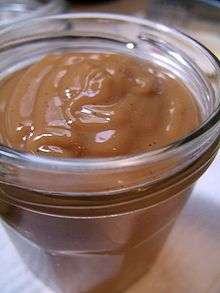Dulce de leche
Dulce de leche (Spanish: [ˈdulse ðe ˈletʃe/ˈdulθe ðe ˈletʃe]; Portuguese: doce de leite IPA: [ˈdosi dʒi ˈlejtʃi]) is a confection from Latin America prepared by slowly heating sweetened milk (most commonly cow milk) to create a substance that derives its flavor from the Maillard reaction, also changing color.[1] Dulce de leche is Spanish for "candy [made] of milk". Dulce de Leche is known as "manjar de leche" or just "manjar".[1]
 A jar of dulce de leche | |
| Alternative names | Manjar, manjar blanco, arequipe, doce de leite (Brazil) |
|---|---|
| Type | Confectionery |
| Region or state | Latin America |
| Main ingredients | Milk, sugar |
| Variations | Cajeta, arequipe |
Preparation and uses

The most basic recipe calls for slowly simmering milk and sugar, stirring almost constantly. Once the mixture thickens and turns the color of caramel it is done. At this point, one must be careful not to burn it.
Another method calls for letting a gallon of milk stand in room temperature for an entire 24 hours. The gasses will spoil the milk and what is left is curd and whey. This is then boiled, causing the solids to flow to the top. The solids are removed and sugar is added. This mixture is stirred until it becomes hard, after which it is removed from the heat and left to cool. After it cools, it is broken up for consumption. Out of a gallon, this method yields about two cups.
Other ingredients such as vanilla may be added for flavor. Much of the water in the milk evaporates and the mix thickens; the resulting dulce de leche is usually about a sixth of the volume of the milk used. The transformation that occurs in preparation is caused by a combination of two common browning reactions called caramelization and the Maillard reaction.[2]
A homemade form of dulce de leche sometimes is made by boiling an unopened can of sweetened condensed milk for two to three hours (or 30 to 45 minutes in a pressure cooker), particularly by those living in countries where it cannot be bought ready-made. This results in a product that is much sweeter than the slow-boiled kind. This method could be dangerous, and should not be done on a stove: if the pot is allowed to boil dry, the can will overheat and explode.[3]
Dulce de leche can be eaten alone or used to flavor candies or other sweet foods, such as cakes, churros, cookies (see alfajor), waffles, crème caramel (known as flan in Spanish-speaking regions and pudim in Portuguese-speaking ones), and ice creams; it is also a popular spread on crepes (panqueques) and toast, while the French confiture de lait is commonly served with fromage blanc.
See also
- Baked milk – Beverage derived from milk
- Banoffee pie
- Basundi
- Brunost
- Cajeta – Confection of thickened syrup
- Caramel – Confectionery product made by heating sugars
- Caramel candy – Confectionery product made by heating sugars
- Flan – Custard dessert with soft caramel on top
- Custard – variety of culinary preparations based on a cooked mixture of milk or cream and egg yolk
- Dum Dums
- Kaymak – creamy dairy product similar to clotted cream
- Krówki
- Maillard reaction – Chemical reaction occurring when baking
- Manjar blanco – Term used in Spanish-speaking area of the world in reference to milk-based delicacies
- Penuche
- Russian candy – A sweet toffee-like dessert
- Ryazhenka – Traditional fermented dairy product
- Sandesh
- Teja
- Tres leches cake – Dessert
References
- "Origen mítico del dulce de leche" [The Mythical Origin of Dulce de Leche] (in Spanish). Clarín. 6 April 2003. Retrieved 8 June 2014.
- McGee, Harold (2004). On Food and Cooking: The Science and Lore of the Kitchen. New York: Scribner. p. 657. ISBN 0-684-80001-2. Retrieved August 8, 2012.
- Kijac, Maria Baez (2003). The South American Table: The Flavor and Soul of Authentic Home Cooking from Patagonia to Rio de Janeiro, with 450 Recipes. Boston, MA: Harvard Common Press. p. 391. ISBN 1-55832-249-3. Retrieved August 8, 2012.
| Wikimedia Commons has media related to Dulce de leche. |